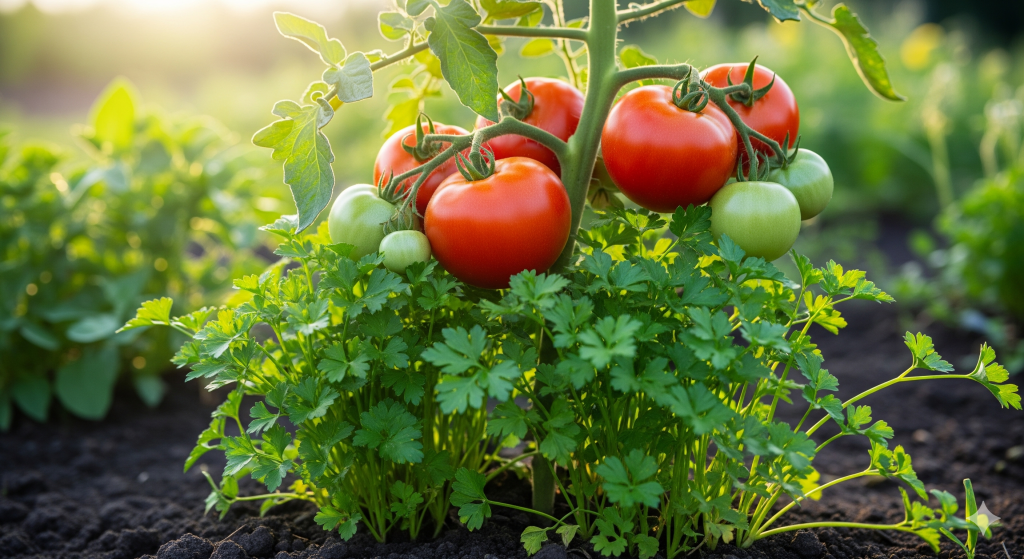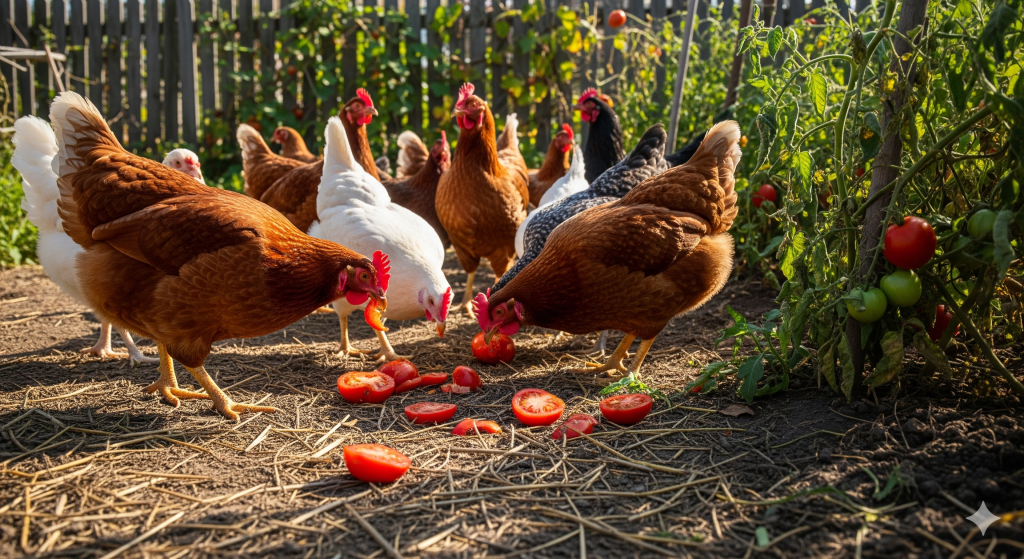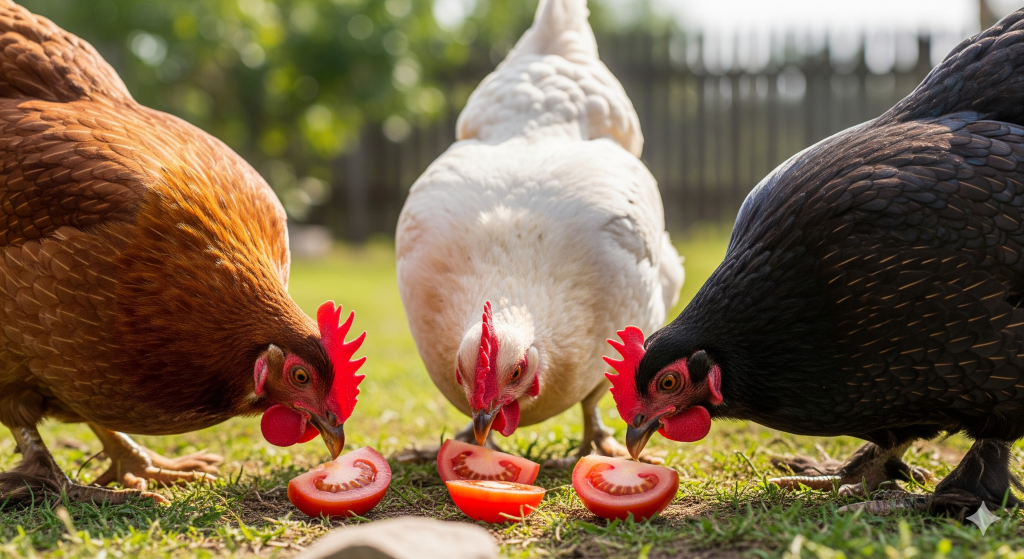Table of Contents
In the intricate and rewarding world of garden design, the practice of companion planting stands out as a cornerstone of organic and sustainable agriculture. By strategically placing certain plants next to each other, gardeners can create a thriving, synergistic ecosystem where plants mutually support one another. This leads to a classic question for anyone who loves the fresh flavors of summer: can I plant parsley and tomatoes together?
The answer is a resounding and enthusiastic yes! Not only can you plant parsley and tomatoes together, but it is one of the most beneficial and time-tested pairings you can have in your vegetable garden. This partnership isn’t just about convenience; it’s a powerful, natural strategy that helps protect your tomatoes from pests, improves the local environment for beneficial insects, and results in healthier, more productive plants. Far from being just a garnish, parsley acts as a quiet guardian for the mighty tomato.
This in-depth guide will explore the fascinating science behind why this pairing works so well, provide practical instructions for planting them together in both garden beds and pots, and highlight other companions that help this versatile herb thrive.
Does Parsley Go with Tomatoes?
Parsley and tomatoes are an exceptional match in the garden, and the primary reason lies in parsley’s remarkable ability to attract an army of “good bugs” that act as a natural pest control service. While some herbs are known for repelling pests with their strong scents, parsley’s main role is that of an “insectary plant”—a plant that provides food and habitat for beneficial predatory insects.
When parsley is allowed to mature and send up its delicate, umbrella-shaped flowers (known botanically as umbels), it becomes an irresistible beacon for a host of your garden’s greatest allies.
- Attracting Hoverflies: Often mistaken for tiny bees, hoverflies are invaluable garden helpers. The adult flies feed on the nectar from parsley flowers, but their true power lies in their larvae. A single hoverfly larva, which looks like a small, camouflaged maggot, is a voracious predator that can consume hundreds of aphids in its lifetime. By planting parsley, you are essentially setting up a nursery for these aphid-destroying insects right next to your vulnerable tomato plants.
- Summoning Parasitic Wasps: Don’t let the name alarm you; these are tiny, non-stinging wasps that are completely harmless to humans but are lethal to common tomato pests. The small flowers of parsley are a perfect nectar source for species like the Braconid wasp. This tiny powerhouse lays its eggs on or inside the destructive tomato hornworm. The wasp larvae then hatch and consume the caterpillar, neutralizing the threat before it can defoliate your plants.
- Welcoming Ladybugs and Lacewings: These iconic “good bugs” are also drawn to the resources provided by flowering parsley. Both the adults and larvae of ladybugs and lacewings are highly effective predators of aphids, spider mites, and other small, soft-bodied pests that can trouble tomato plants.
Beyond pest control, the low-growing, bushy habit of parsley can also act as a living mulch around the base of the taller tomato plants, helping to shade the soil, suppress weeds, and retain moisture.
Ready to Take Your Self-Sufficiency to the Next Level?
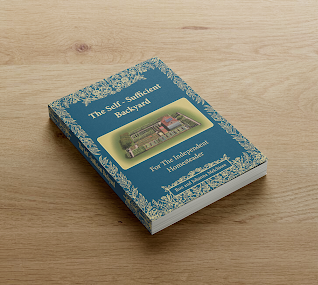
If you love the self-sufficient lifestyle, this is the only guide you’ll ever need. Learn how to generate your own power, secure your water supply, and become truly independent. No fluff, just actionable plans.
➡️ Check out The Self-Sufficient Backyard and start your journey today!
Can I Plant Parsley with Tomatoes in the Ground?
Yes, planting parsley and tomatoes together directly in a garden bed is the most common and effective way to leverage this beneficial partnership. Their contrasting growth structures are perfectly complementary, allowing them to occupy different vertical spaces without competing. The tall, sun-reaching tomato plant and the low, lush parsley create a perfect multi-story environment.
For the best results, use parsley as an underplanting or as a border around your tomato plants.
- Proper Spacing: Give each plant enough room to thrive. Plant your parsley starts or seeds about 10-12 inches away from the base of your tomato plants. This ensures their root systems can establish without being in direct competition.
- Sunlight Management: Tomatoes are sun worshippers, requiring at least 6-8 hours of direct sunlight to produce fruit. Parsley, while it enjoys sun, can be sensitive to the scorching heat of the late afternoon in many US climates. Planting it at the base of a taller, well-staked tomato plant provides a perfect microclimate. The parsley will receive plenty of morning sun but will be shielded during the hottest part of the day, which can prevent its leaves from scorching and delay the plant from bolting (going to seed) prematurely.
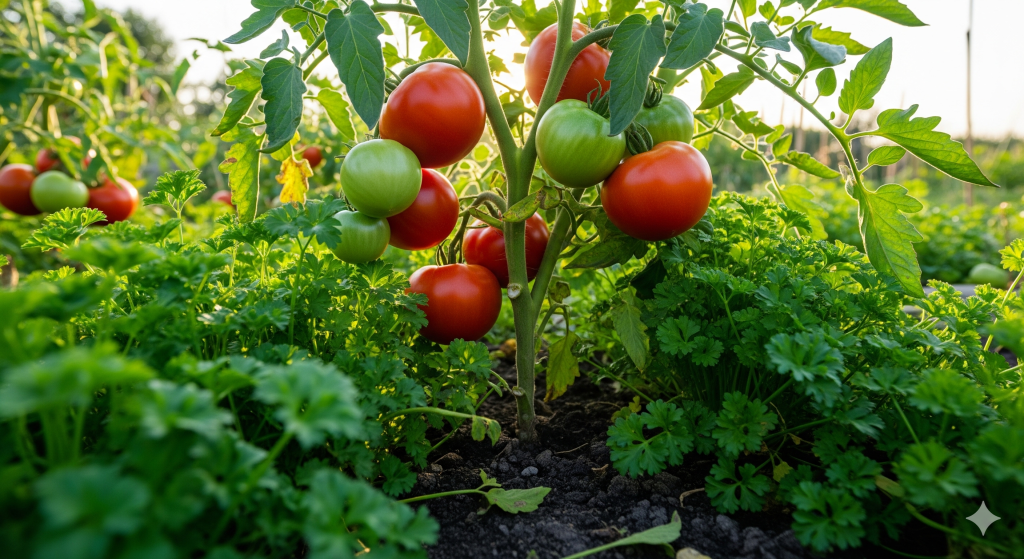
Can I Plant Parsley with Tomatoes in Pots?
This is another excellent strategy, particularly for urban gardeners with patios, balconies, or limited yard space. Planting parsley and tomatoes together in a single large container is a highly efficient way to maximize your growing area and enjoy the rewards of companion planting.
Here’s how to ensure success when planting this duo in a pot:
- Pot Size is Paramount: This is the most critical factor for container success. Both plants need ample room for their root systems to grow and access nutrients and water. Choose a large container, at least 10-15 gallons (or roughly 18-24 inches in diameter), to accommodate a single tomato plant and one or two parsley plants. Excellent drainage holes are non-negotiable.
- Use High-Quality Potting Mix: Never use soil from your garden in pots. It will compact quickly, choke the roots, and drain poorly. Fill your pot with a high-quality, well-draining potting mix that is rich in organic matter like compost.
- Strategic Placement: Plant the tomato seedling in the center of the pot where it has the most room to establish its deep root system. Plant the parsley near the edges of the container. This allows the parsley to get plenty of light while also spilling attractively over the sides of the pot, creating a beautiful “spiller” effect in your container arrangement.
- Consistent Watering and Feeding: Plants in containers dry out much faster than those in the ground, especially on hot, sunny days. Check the soil moisture daily and water thoroughly whenever the top inch or two feels dry. Because the frequent watering leaches nutrients from the soil, you will need to feed your potted duo with a balanced liquid fertilizer every 2-3 weeks during the peak growing season.
Parsley Companion Plants
Parsley is a famously friendly herb that gets along with a wide variety of plants, making it a versatile addition to any garden bed. Besides tomatoes, here are some of its best companions:
- Asparagus and Corn: Parsley provides good ground cover and attracts beneficial predators that can help protect these tall crops.
- Peppers and Eggplants: As fellow members of the nightshade family, they benefit from parsley’s ability to attract predatory insects in the same way that tomatoes do.
- The Brassica Family: Planting parsley near cabbage, broccoli, kale, and cauliflower can help create a more diverse and pest-resilient environment.
- Roses: A classic pairing in ornamental gardening. The presence of parsley is believed to enhance the fragrance of roses and deter some common rose pests like aphids.
- Chives and Garlic: These alliums can help deter aphids, which sometimes target parsley.
The main plants to keep parsley away from are other members of its own family, like carrots and parsnips, if you are a seed-saver. They can cross-pollinate, which would affect the purity of the seeds you collect.
Conclusion
The combination of parsley and tomatoes is a shining example of companion planting at its most effective. It’s a partnership that is as productive and beneficial in the garden as it is delicious and complementary on the plate. By planting parsley as an understory or border for your tomato plants, you are not just growing a versatile culinary herb; you are actively cultivating a healthier and more balanced garden ecosystem. You are creating a welcoming habitat for the beneficial insects that serve as your own personal, organic pest control squad.
Whether you are working with a large in-ground garden, a raised bed, or a simple container on your patio, this pairing is a simple, intelligent, and effective strategy. It helps you manage pests naturally, improves the microclimate around your plants, and provides you with two of the most essential ingredients for countless fresh and flavorful meals.

